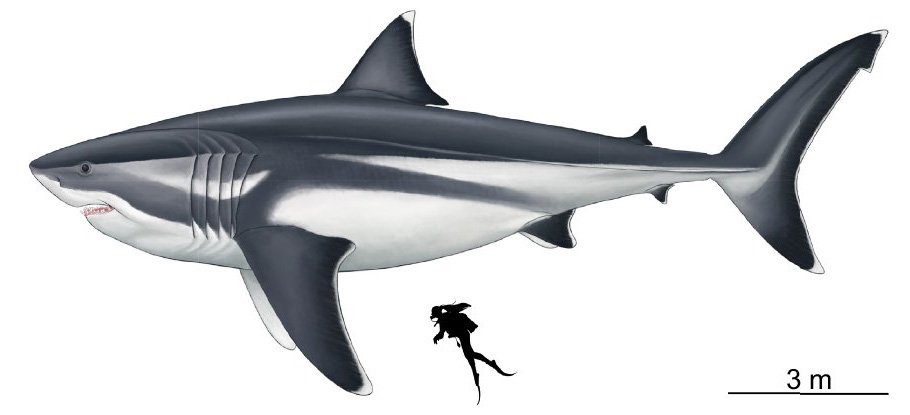A shark with teeth as big as your hand has to be huge. But when teeth are all you have to go on, you'll need to think outside the box to work out what the rest of the long-extinct monster looked like.
It turns out the pelagic terror referred to as Megalodon might have looked a little more cartoonish than Hollywood would have us believe. It was certainly huge - but relative to its impressive length, it might have also had a cute snoot and big, flappy fins to boot.
To get a better sense of the extinct giant's precise proportions, palaeontologists from the University of Bristol and Swansea University in the UK turned to the growth patterns of its closest living relatives.
 New reconstruction of Megalodon body proportions. (Oliver E. Demuth)
New reconstruction of Megalodon body proportions. (Oliver E. Demuth)
You'd think this meant collecting data on white sharks (Carcharodon carcharias). After all, these modern apex predators are a convenient point of comparison for a giant shark that cruised our oceans for around 20 million years, before dying out just a few million years ago.
Taxonomy is tricky enough when you've got whole bodies to work with. But the cartilage making up shark skeletons doesn't stick around for long after their death, meaning palaeontologists are left mostly with just teeth to base their estimates on.
And the exact positioning of Megalodon's branch on the shark family tree is a bit of a confusing mess. Originally, back in the late 19th century, Megalodon was also placed in the genus Carcharodon, linked directly with great white sharks under the family Lamnidae.
This has led to depictions of the shark as a white shark, only a few times longer, reaching anywhere from 15 to 18 metres from nose to tail.
Not everybody was convinced that this is a fair comparison. Some think the shape of the animal's teeth implies it was the end of the line for the extinct family Otodontidae, in which case it's part of the genus Carcharocles, or perhaps Otodus.
This is the lineage the team of palaeontologists have based their latest assessment on, an assumption that implies Megalodon had a slightly more complicated pedigree.
"Megalodon is not a direct ancestor of the great white but is equally related to other macropredatory sharks such as the makos, salmon shark and porbeagle shark, as well as the great white," says Catalina Pimiento from Swansea University.
"We pooled detailed measurements of all five to make predictions about Megalodon."
Those predictions were based on a mix of mathematical analyses chosen to resolve the question of how anatomical features like fins, head, and tail scaled as the shark expanded in length.
Fundamental to their calculations was the question of how the proportions of related sharks may have adjusted as they aged.
Baby humans, for instance, aren't exactly miniature adults. A 1.6-metre-tall newborn won't pass for a bank manager, no matter how fancy their suit looks.
Sharks, on the other hand, just might get away with it.
"[W]e were surprised, and relieved, to discover that in fact the babies of all these modern predatory sharks start out as little adults, and they don't change in proportion as they get larger," says palaeontologist Mike Benton from the University of Bristol.
This means they could take the growth curves of sharks believed to be related to Megalodon and apply them to their extinct cousin, comfortable that its own fins, head, and tail will expand in a similar manner right up to its estimated final size.
We can now picture a 16-metre-long adult Otodus megalodon with a head that was nearly a third of the size of its entire body, at around 4.65 metres, a tail fin of around 3.85 metres, and a dorsal fin of 1.62 metres.
If you want some perspective, this would be like parking three cars, and standing on the middle one. The first car would be around the length of its head, and your height would be the height of its dorsal fin.
For lead author Jack Cooper, a researcher who had just finished his post-grad in palaeontology at the University of Bristol, it was an exciting image to describe.
"Megalodon was actually the very animal that inspired me to pursue palaeontology in the first place at just six years old, so I was over the moon to get a chance to study it," says Cooper.
"This was my dream project. But to study the whole animal is difficult considering that all we really have are lots of isolated teeth."
Whether this new way of imagining a classic prehistoric beast is more terrifying or a bit more adorable, we'll leave up to you.
This research was published in Scientific Reports.
#Nature | https://sciencespies.com/nature/palaeontologists-reveal-what-could-be-the-true-proportions-of-the-fearsome-megalodon/
No comments:
Post a Comment